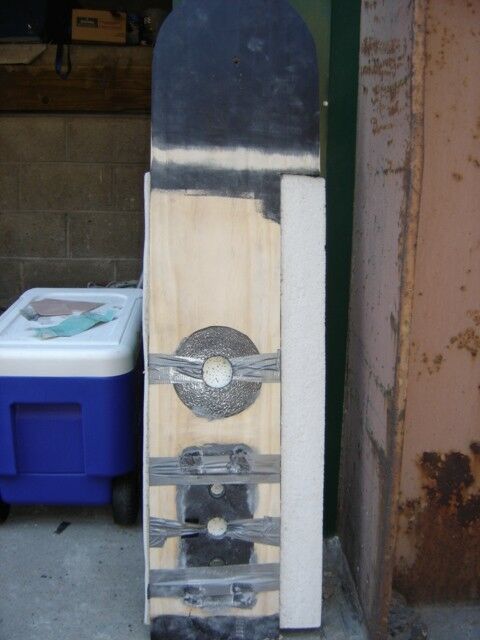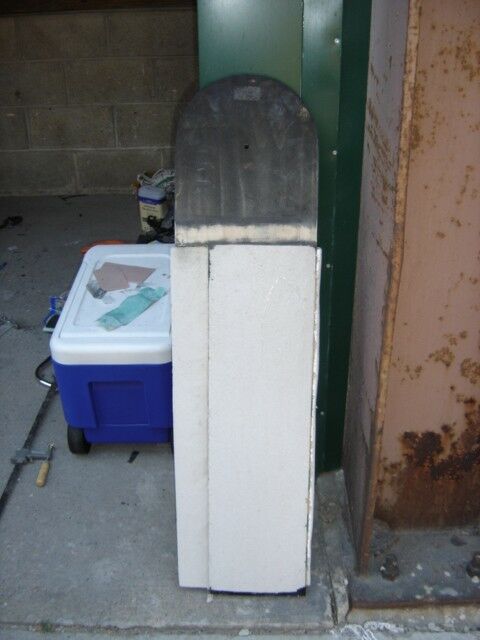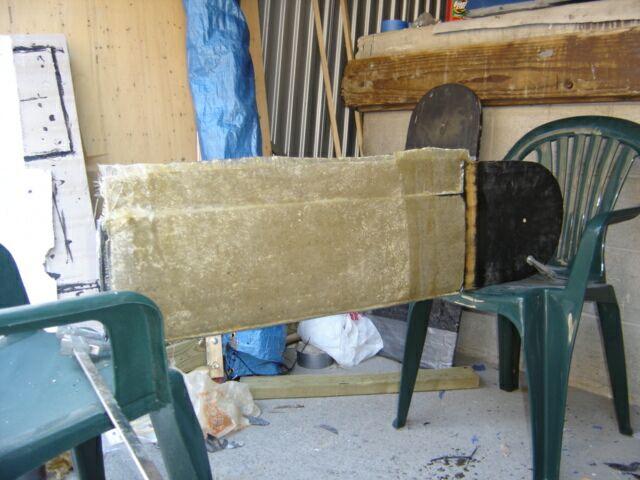The Sequel To The Sailboat Rudder - Naca 0012 and 0015 foil
By Phil Keck #39 "S.S. Pubert" (5ar)
For this rudder, I decided to try a couple of new things. As you can see in this image, I added weights. I wanted to try using exercise weights instead of melting lead, and here's what it looked like. I used quiksteel epoxy (from Home Depot) to glue the weights to the wood, and then used duct tape to hold them in place while the epoxy cured. I actually left the duct tape in when I sealed everything because I didn't see any real reason to take it out.
The bottom weight is the same kind of weight that you find on the big multi-station work out machines at gyms. I got it at a used exercise equipment store for 8 bucks. The other weight is a 2 1/2 pound weight. The extra width of the foil shape displaces more water than when you have a flat plate, so you do need extra weight, but I ended up using so much resin on this thing that it weighs more than it needs to.

Here you can see the second change that I made in the design. Instead of using pink foam and sanding it down, I used acoustic ceiling tiles. The tiles are much easier to shape, but they produce loads of dust, so be sure to use a dust mask.

This (kind of) shows the third and final change to the procedure: a good fiberglass job. I experimented with doing a craptacular fiberglass job on the first rudder I made, and the results where unsurprising. The fiberglass separated from both the foam and the wood after just a couple of trips out. This let water in, so whenever I pulled the rudder out of the water, it looked like it was pregnant.
The first thing I did was sand a band of paint off of the wood this time around to allow a better bond around the "neck" of the rudder. You can see this in all of the pictures.
I read some great step by step instructions on how to do a good fiberglass job at another website, and chose not to follow them the first time. Which was stupid.
Here's what I did this time:
1. Stand the rudder so that the leading edge is pointed up to the sky, and the trailing edge is toward the ground (I clamped mine to some lawn chairs to hold it steady). The final picture on this page is with the rudder flipped over the other way around, so ignore it.
2. Get your pieces of fiberglass cut and all ready to go. I recommend starting off with pieces that span about 15 inches of the leading edge, and when draped over the rudder, will cover the entire length of the rudder from leading to trailing edge plus an extra inch. If you have a friend helping, you can do bigger pieces, but this size is more or less manageable for one person.
3. Take the pieces of fiberglass and roll them up like a scroll of paper, so that you have two rolls that meet in the middle of each piece.
4. From here on out, you have to work quickly, so have all of your stuff ready to go. Mix up your polyester or epoxy or whatever you're using, and pour this mix onto one of the scrolled up pieces of fiberglass and smear it all around with a plastic spreader. Continue doing this until the entire piece of fiberglass is more or less transparent.
5. If the fiberglass is going to be in contact with wood anywhere, smear some resin directly onto the wood first. Then lay your scroll of fiberglass so that the middle of it is right on the leading edge of the rudder. Unroll the fiberglass and smooth it out. Smear some extra resin on there, as some resin will get absorbed by the ceiling tiles, and then smooth that out. Smooth from the leading edge toward the trailing edge.
6. Continue on down for the rest of the rudder! I recommend two or three layers of glass because there always seems to be a hole somewhere in every layer.
7. To seal up the bottom of the rudder, I stood the rudder straight up with the bottom toward the sky, and just started pouring resin all over the bottom of it. Some ran down inside the rudder, which is fine, but eventually, it just started filling up until I had a solid block of resin at the bottom! It weighs a ton, which sucks, but feels very sturdy, which is good.
I only took one picture during the fiberglass procedure because I didn't want to stop halfway through and screw up the glassing job. So, as long as you have all of your stuff together everything should go great!
